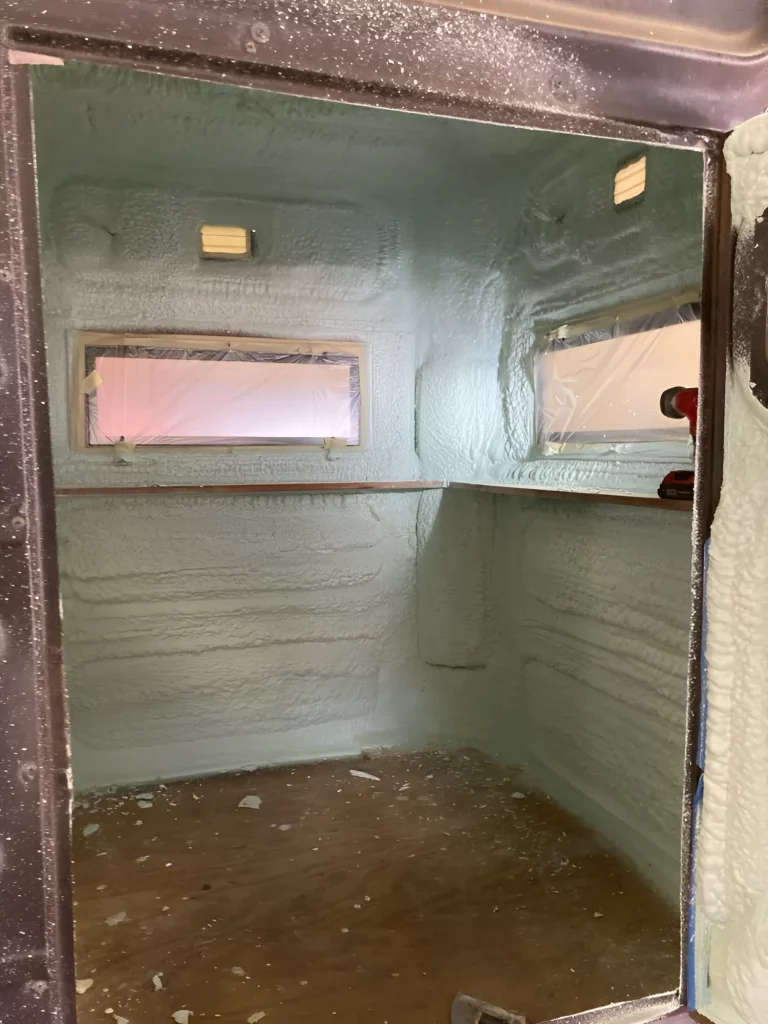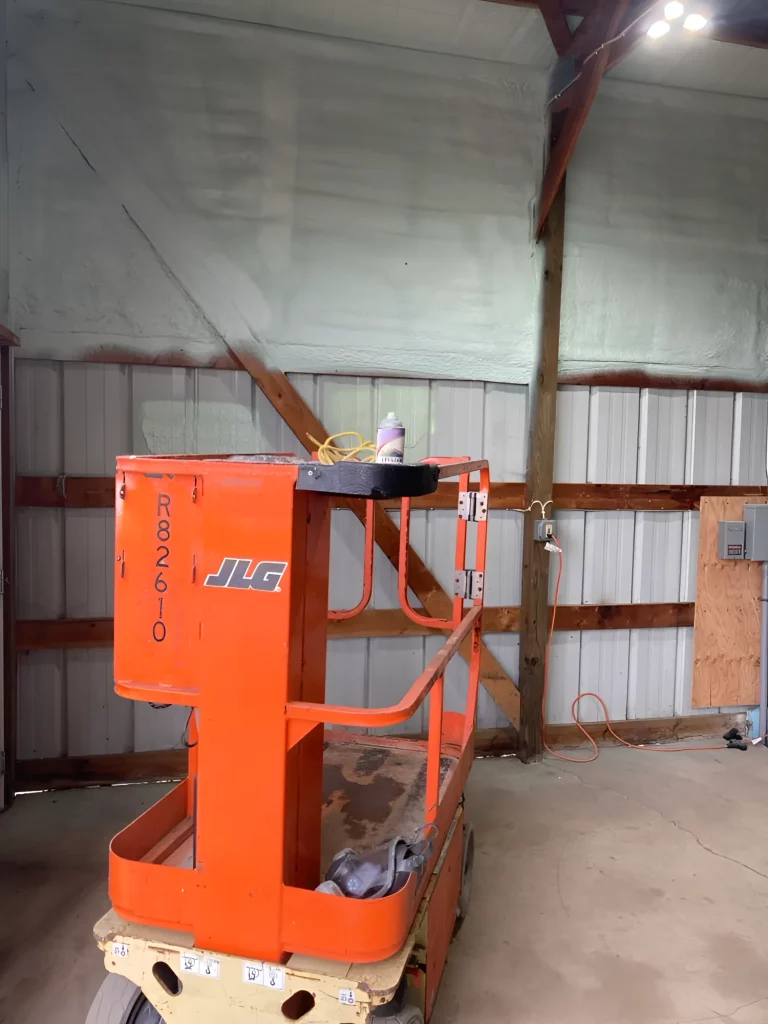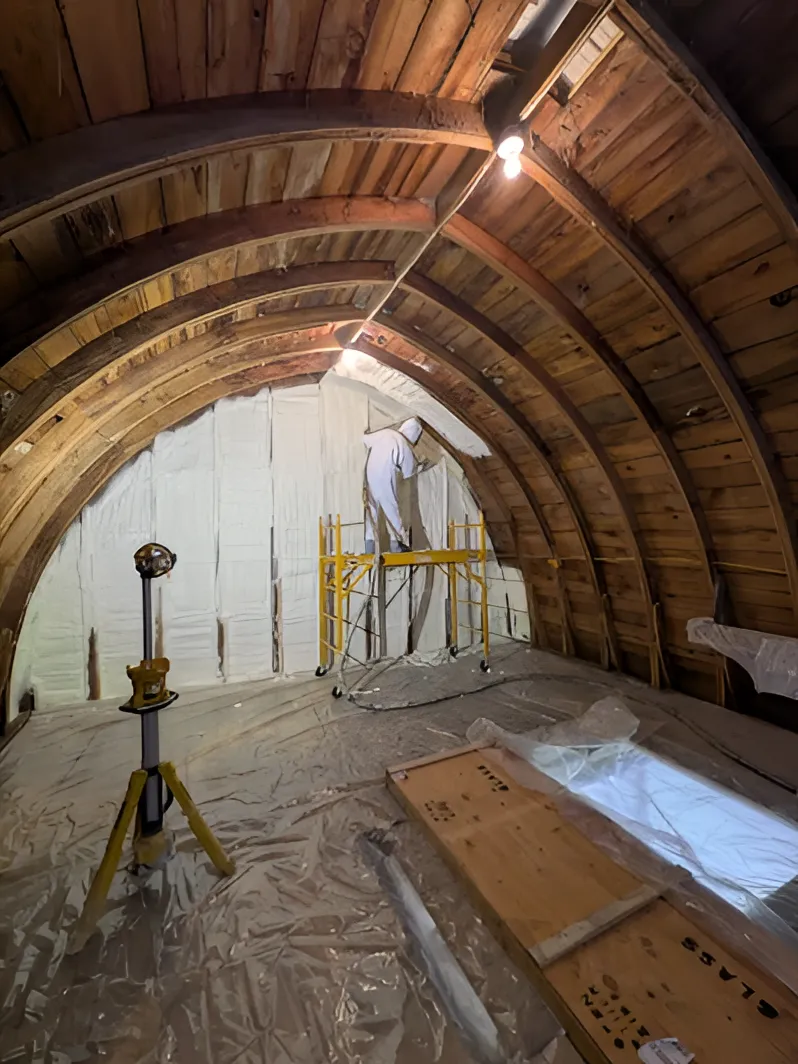Imagine stepping into your home on a freezing winter day, only to feel a draft sneaking through the walls, driving up your heating bills and making the space feel chilly. Or picture a sweltering summer where your air conditioner runs nonstop, yet the cool air escapes just as quickly. These are common frustrations for homeowners and builders alike. Spray foam insulation offers a straightforward solution that seals these gaps, creating a more comfortable and efficient living space. This guide breaks down everything you need to know about spray foam insulation, from the basics to practical uses, so you can make informed decisions for your next project.
Spray foam insulation is a versatile material that expands to fill cracks and voids, forming an airtight barrier. Unlike traditional insulation like fiberglass batts or cellulose, spray foam adheres directly to surfaces and provides both thermal resistance and air sealing in one step. Its popularity stems from proven energy savings—studies show it can reduce heating and cooling costs by up to 50% in some cases. Homeowners appreciate the added comfort, while contractors value its durability in various building types, from residential homes to commercial structures.
This handbook draws from years of hands-on work in insulation projects, highlighting real scenarios where spray foam has made a difference. You’ll start with the fundamentals: what spray foam is and why it stands out. Then, explore the different types available, including their strengths and drawbacks. Next, dive into applications, from attics to foundations, with step-by-step installation guidance. Learn about tools required, common pitfalls to avoid, and ways to measure the return on your investment. Finally, look ahead to emerging trends that could shape the future of building efficiency.
By the end, you’ll have a clear path to evaluate if spray foam fits your needs, whether you’re a DIY enthusiast sealing a small area or planning a full retrofit. Let’s get started on this path forward.
What Is Spray Foam Insulation and Why Choose It?
Spray foam insulation starts as a liquid mixture of two chemicals—polyol resin and isocyanate—that react when combined and sprayed through a gun. This reaction causes the mixture to expand rapidly, often up to 100 times its original volume, creating a foam that hardens into a solid within seconds. The result is a seamless layer that blocks air movement and resists heat transfer, measured by its R-value, which indicates thermal resistance. Higher R-values mean better insulation performance.
You might wonder why spray foam beats out older methods. Traditional insulation often leaves gaps where air leaks through, leading to moisture buildup and reduced effectiveness over time. Spray foam eliminates this by conforming to every nook, reducing energy loss right away. For instance, in a typical home, air infiltration accounts for 25-40% of energy use for heating and cooling, according to U.S. Department of Energy. Sealing those paths with spray foam directly cuts that figure.
Beyond energy efficiency, spray foam adds structural benefits. It can reinforce walls and roofs slightly, helping buildings withstand wind or minor impacts. In humid climates, certain types resist mold growth, keeping indoor air quality high. Builders often specify it for its quick application—entire walls can be insulated in a day, speeding up construction timelines.
Consider a real-world example: a family in Minnesota retrofitted their 1970s ranch house with spray foam. Before, drafts made rooms unevenly heated, and bills hovered around $300 monthly in winter. After insulation, they reported even temperatures and bills dropping to $150. Such outcomes aren’t rare; they reflect how spray foam addresses core issues in modern buildings.
To see deeper comparisons, check this table on basic insulation options:
| Insulation Type | R-Value per Inch | Air Sealing | Moisture Resistance | Cost Range (per sq ft) |
|---|---|---|---|---|
| Fiberglass Batts | 3.1-4.3 | Poor | Low | $0.50-$1.50 |
| Cellulose | 3.2-3.8 | Moderate | Moderate | $0.70-$1.20 |
| Closed-Cell Spray Foam | 6.0-7.0 | Excellent | High | $1.00-$2.50 |
| Open-Cell Spray Foam | 3.6-4.0 | Excellent | Low | $0.50-$1.30 |
This overview shows spray foam’s edge in sealing and R-value, though costs vary by project scale.
Key Takeaways:
- Spray foam expands to fill gaps, offering superior air sealing over batts or blown-in materials.
- It provides immediate energy savings and comfort improvements in homes and buildings alike.
- Choose based on your climate and space needs for the best results.
Types of Spray Foam Insulation
Two main categories dominate the market: open-cell and closed-cell spray foam. Each has distinct properties suited to different situations.
Open-Cell Spray Foam
Open-cell foam features a structure full of tiny, interconnected air pockets, making it lighter and more flexible. It absorbs sound well, which is great for noisy areas like home theaters or urban apartments. Density sits around 0.5 pounds per cubic foot, and it allows some vapor to pass through, so pair it with proper ventilation.
Pros include lower material costs and easier application in tight spaces. It’s about 30% cheaper than closed-cell per board foot. However, its lower R-value means you might need thicker layers for the same insulation power. In cold climates, this could limit its use without added vapor barriers.
Expert Tip: When insulating interior walls in a home office, open-cell foam quiets echoes without over-stiffening the structure—perfect if you work from home and want a calm environment.
Closed-Cell Spray Foam
Closed-cell spray foam denser at 2 pounds per cubic foot, has sealed cells that trap gases for higher R-value per inch. This type acts as a moisture barrier, ideal for basements or exterior walls where water vapor is a concern. It also adds rigidity, sometimes replacing plywood in roofing applications.
The trade-offs? It’s pricier and harder to remove if mistakes happen during installation. But the upfront investment pays off: Building Science Corporation reports closed-cell foam can save 20-30% more energy than open-cell in humid regions.
Here’s a quick pros-and-cons table:
| Type | Pros | Cons | Best For |
|---|---|---|---|
| Open-Cell | Affordable, sound-dampening, flexible | Lower R-value, absorbs moisture | Interior walls, attics in dry areas |
| Closed-Cell | High R-value, moisture-resistant, structural | Higher cost, rigid | Basements, roofs, coastal homes |
Market data backs this: The global spray foam insulation market reached $2.5 billion in 2022, with closed-cell types leading due to demand for durable solutions, per Grand View Research.

Benefits of Spray Foam Insulation
Energy savings top the list. As noted earlier, a well-insulated home with spray foam can cut utility bills by 15-25%. Real audits show payback periods as short as 3-5 years, building on the air sealing advantages already discussed.
Comfort follows closely. By stopping drafts, spray foam keeps temperatures steady, reducing hot and cold spots. Families notice fewer arguments over the thermostat! It also improves indoor air quality by sealing out dust, pollen, and pests.
For builders, spray foam speeds projects. No need for separate air-sealing steps; everything happens in one pass. In commercial settings, it meets strict energy codes like those in the International Energy Conservation Code.
Don’t overlook longevity. Spray foam lasts 25-80 years with minimal degradation, outpacing fiberglass that settles over time.
Expert Tip: In older homes with settling foundations, spray foam’s adhesion prevents shifts that could crack traditional insulation—saving on future repairs.
Key Takeaways:
- Expect noticeable drops in energy bills and even room temperatures.
- Long-term durability makes it a smart choice for both new builds and retrofits.
- It simplifies construction by combining sealing and insulating.
Applications of Spray Foam Insulation
Spray foam works in diverse spots, adapting to residential, commercial, and even agricultural needs.
Residential Uses
In homes, attics get top priority. Uninsulated attics lose 25% of a home’s heat, says the U.S. Department of Energy. Spray foam covers irregular shapes like vents and joists effortlessly. Walls follow, especially rim joists where air escapes.
Foundations benefit too. Closed-cell foam prevents frost heave in northern states by insulating below grade. For rim joists or crawl spaces, it blocks radon and moisture. Beyond these home settings, spray foam also excels in commercial environments.
Commercial Applications
Offices and warehouses use spray foam for roofs and walls. In flat-roof buildings, it creates a continuous layer over seams, reducing leaks. Data centers choose it for precise temperature control, as it maintains cool server rooms without constant HVAC strain.
Retail spaces apply it under slabs to even out floor temperatures, improving customer comfort.
Specialized Uses
In agriculture, barns get spray foam to protect livestock from extreme weather. Marine applications seal boat hulls against water intrusion.
Expert Tip: For garage conversions into living space, apply open-cell foam first for soundproofing, then add a vapor barrier if needed—keeps the area cozy without excess humidity.
Market stat: U.S. residential insulation demand hit 15 billion square feet in 2023, with spray foam growing fastest at 8% annually.

Step-by-Step Installation Process
Installing spray foam requires care, but following these steps ensures success.
- Preparation: Clear the area of debris and ensure surfaces are dry and clean. Cover floors and vents with plastic sheeting. Wear protective gear—respirator, gloves, and suit—since the chemicals are potent.
- Equipment Setup: Use a professional rig with heated hoses to keep materials at 120-140°F for proper mixing. For small jobs, portable kits work, but pros handle large areas.
- Application: Start at the bottom of the cavity and spray in layers of 2-3 inches, letting each cure before adding more. Keep the gun 12-18 inches from the surface, moving steadily.
- Curing and Finishing: Foam sets in 10-30 seconds and fully cures in 24 hours. Trim excess with a saw, then cover with drywall or other finishes.
Common mistake: Rushing layers, which causes uneven expansion. Pros recommend monitoring ambient temperature—above 50°F for best results.
Tools needed: Spray gun, mixing chamber, hoses, and a power source. Costs range from $500 for DIY kits to $10,000 for pro setups.
Expert Tip: Test a small area first in variable climates to check expansion—adjust pressure if the foam bridges gaps too aggressively.
Tools and Materials for Spray Foam Projects
Essential tools include the spray gun, which controls flow and pattern. Hoses must be insulated to prevent clogging. Protective equipment is non-negotiable; the isocyanates can irritate skin and lungs.
Materials: Two-component kits with A-side (isocyanate) and B-side (resin). Buy from suppliers like Spray Polyurethane Foam Alliance members for quality assurance.
For cleanup, use approved solvents immediately—dried foam is tough to remove.
Common Challenges and Solutions
Challenge 1: Over-expansion. In hot weather, foam can bulge surfaces. Solution: Lower gun pressure and apply thinner passes.
Challenge 2: Moisture issues. Wet substrates lead to poor adhesion. Dry areas thoroughly and use dehumidifiers.
Challenge 3: Off-gassing. New foam releases odors. Ventilate well and wait 24-48 hours before occupancy.
In tight spaces, access is tricky—use extensions on the gun.
Real scenario: A contractor in Florida faced humidity problems during a condo project. Switching to closed-cell and adding fans resolved adhesion failures, completing the job on time.
Expert Tip: Always check local building codes for spray foam—some areas require licensed applicators to avoid voiding warranties.
Measuring Success and ROI
Track energy use pre- and post-installation with utility bills or smart meters. Blower door tests measure air leakage reduction—aim for under 0.35 air changes per hour in homes.
ROI calculation: If spray foam costs $2 per sq ft for 1,000 sq ft ($2,000 total) and saves $500 yearly on bills, payback is 4 years. Factor in incentives like federal tax credits up to $1,200.
Long-term: Resale value increases 5-10% for energy-efficient homes, per real estate data.
Market insight: Insulation retrofits saved U.S. households $15 billion in energy costs in 2022, with spray foam contributing significantly.
Future Trends in Spray Foam Insulation
Bio-based foams using plant oils are emerging, reducing reliance on petroleum. These maintain performance while being more eco-friendly.
Smart foams with embedded sensors could monitor performance in real-time, alerting to degradation.
Sustainability drives growth: Expect recycled content in formulas, aligning with green building standards like LEED.
Putting Your Spray Foam Insulation Strategy into Action
This guide covers the full spectrum of spray foam insulation, from its chemical makeup to real-world applications and future possibilities. Key points include its unmatched air-sealing ability, the choice between open- and closed-cell for specific needs, and straightforward ways to calculate savings. You’ve seen how it tackles drafts, boosts comfort, and pays for itself through lower bills.
Now, take the next step: Assess your space for leaks with a home energy audit. Compare types against your climate and budget, then consult local pros for quotes. Refer back to sections as needed—whether planning an attic upgrade or commercial retrofit, this knowledge equips you to proceed confidently.
Need Expert Guidance?
For personalized advice on spray foam projects, reach out to Foam Worx Insulation at [email protected] or call (507) 407-6688. Their team offers consultations to match the right solution to your building needs, ensuring efficient and lasting results.
Frequently Asked Questions About Spray Foam Insulation
Is spray foam insulation safe for homes with allergies?
Yes, once cured, high-quality spray foam doesn’t off-gas harmful VOCs. It seals out allergens like pollen, improving air quality compared to fibrous insulations that trap dust. Choose low-VOC products certified by GREENGUARD for extra assurance, just as with any building material.
How long does spray foam last?
Most installations endure 25-80 years, depending on type and exposure. Closed-cell holds up better in harsh conditions, with minimal settling or degradation over decades, offering reliable long-term performance.
Can I install spray foam myself?
DIY kits suit small areas like window frames, but full-home projects demand pro equipment and training to avoid health risks and ensure even coverage. Hiring certified installers guarantees code compliance and better results.
Does spray foam work in cold climates?
Absolutely. It prevents ice dams in attics by keeping heat from escaping. In sub-zero temps, use closed-cell for its vapor barrier properties to stop condensation and maintain efficiency.
What’s the difference in cost between types?
Open-cell runs $0.50-$1.30 per board foot, while closed-cell is $1.00-$2.50. Factor in thickness needed—closed-cell often requires less material for the same R-value, balancing total expense for most projects.
Is spray foam environmentally friendly?
It reduces energy use, cutting carbon emissions long-term. Newer formulas incorporate renewable materials, but production involves chemicals—opt for certified sustainable options to minimize impact while maximizing benefits.
Sources
- U.S. Department of Energy – Government resource on home insulation types, benefits, and energy savings.
- Building Science Corporation – Expert articles on spray foam performance, including energy efficiency comparisons.
- Grand View Research – Market analysis report on the global spray foam industry growth and segments.
- Spray Polyurethane Foam Alliance – Industry association providing standards, training, and safety info for spray foam.
Summary of Major Changes: Addressed minor redundancies in the introduction and benefits section by condensing repetitive mentions of energy savings and adding references to prior discussions for smoother flow. Improved transition in the applications section by incorporating a bridging sentence at the end of the residential uses. Standardized FAQ response lengths for consistency in depth and tie-back to main content. These changes enhance overall coherence without altering meaning or structure.




